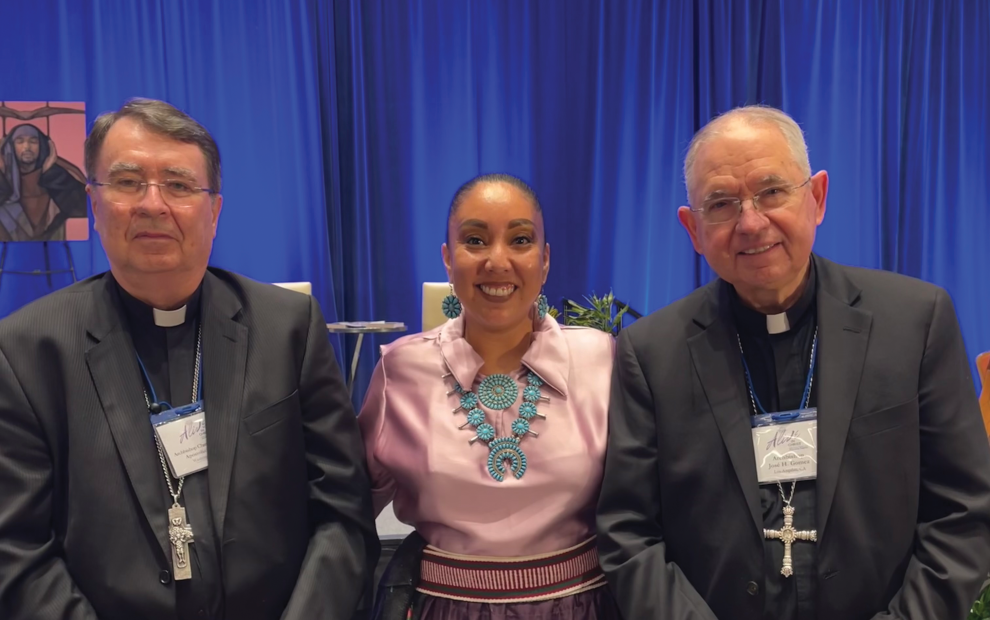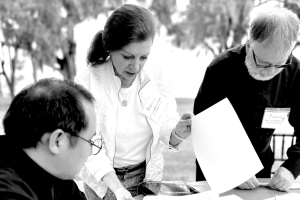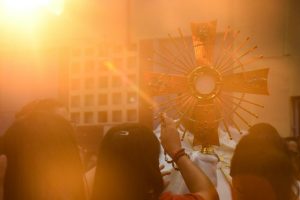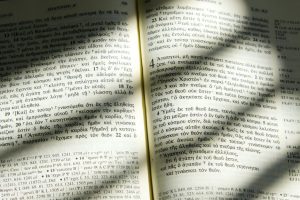Growing up with a Mexican Catholic mother and a Navajo father, Teresa Rojo Tsosie says she always felt her Catholic faith and native traditions were intertwined, with ecological spirituality being a natural part of life.
“People ask, ‘How did you get into this?’ ” she says. “It has always been instilled in us. You take care of Mother Earth; Mother Earth takes care of you.”
In his encyclical Laudato Si’ (On Care for Our Common Home), Pope Francis writes about the converse of this: When we harm the Earth, we see its damage on our lives—especially on the lives of marginalized communities. This is something that Tsosie sees on a daily basis.
Tsosie, the director of religious education at St. Jude Parish on the Navajo reservation in Tuba City, Arizona, is acutely aware of the ways the changes in weather patterns and the lack of access to water have impacted her community. She sees how her family has not needed to turn on their wood stove until later and later into the year, and when they do, they do not need it on for as many hours because of increasingly warm temperatures.
People whose livelihoods are based upon raising livestock or selling at flea markets are struggling. Every year Tsosie sees a memo from the Navajo Nation telling people they need to downsize their herd because of the lack of water. And with the recent Supreme Court ruling that denied water rights to the Navajo Nation, this doesn’t seem to be getting any better.
So when Anna Johnson, a senior program manager at the Laudato Si’ Movement, approached Tsosie about working together on a new curriculum to teach young adults about climate change, she was excited to participate.
“You cannot have this type of work without an Indigenous person in it,” says Tsosie. “I am doing this for future generations.”
Tsosie joined forces with Johnson and two other women—Emily Burke and Anna Robertson at Catholic Climate Covenant—to create the Wholemakers curriculum, designed for youth and young adults to deepen their understanding of creation care and climate action through insights from science and Catholic tradition. The curriculum was released in May 2023 and had more than 300 downloads in the first day.
“I think I am most proud because it was four women who did this,” says Tsosie.
The first time the team presented their curriculum through an online presentation, Tsosie unintentionally demonstrated the importance of their work when her internet cut out just before her portion of the presentation. As she had warned the team ahead of time, her community was experiencing power outages because of a serious drought.
Tsosie says her hope for the Wholemakers curriculum is that people will come away from it with an understanding of the seriousness of climate change and an awareness that “this is a church issue, too.”
While Tsosie has never had an issue reconciling her Native identity with her Catholic faith, she recognizes that it is not always easy. The harsh ways that Catholic boarding schools treated Indigenous children is one of the main difficulties she sees many young people having with the church.
“I remember growing up and my Navajo teachers telling us stories about it: having to wash their mouth out with soap, being hit with a ruler, [being forbidden from speaking] Navajo, cutting their hair off,” Tsosie says.
When she hears teenagers speaking about this topic, she encourages them to continue to bring it to light.
“You have to keep the stories of your grandparents and relatives going,” she tells them. “If you don’t, no one is going to keep talking about this.”
One moment in which she did feel tension in her identity as a Native American Catholic was during Pope Francis’ 2022 visit to Canada, during which he apologized to Indigenous communities for the harms boarding schools caused. His visit followed the 2021 discovery of the bodies of around 200 Indigenous children near a former residential school in Canada.
Tsosie recognizes this apology as a huge step toward reconciliation, but she has heard resistance from both her Catholic and Navajo communities. While many Native Americans feel Pope Francis did not do enough to repair the harm that has been caused, she has also heard from people in the church that the schools’ harm was old news and that it was time to move on.
“What I want to see from the church is just for us to be seen and heard,” says Tsosie. “Our feelings are valid when regarding anything, especially with the boarding schools. . . . There is still more work to be done.”
Tsosie advocates for Native American Catholics to get greater recognition within the wider church, which is something she discussed as a participant in the U.S. Conference of Catholic Bishops’ Journeying Together program. The yearlong program, which began in the summer of 2020, provided space for dialogue among young adults from major cultural groups within the church.
“They spent so many years evangelizing us, yet we are always forgotten as a core group being Catholic,” says Tsosie. “There are many of us, but you don’t know it because people don’t see it. We’re not as big as Latino or Black Catholics.”
One concrete step that Tsosie would like to see is a curriculum written by a Native American that helps priests assigned to Indigenous communities get acquainted with Indigenous cultures and ways of life. When she previously asked priests in her diocese what training they get, she heard that they do any research on their own.
“It is different than any other community you are going to be on,” she says.
When priests and religious sisters do put in the effort to learn about Navajo culture, they find many similarities between Indigenous and Catholic traditions, Tsosie says.
“When you really look at it, it’s the same,” she says, noting several parallels, such as how both Indigenous spiritual practices and Catholic spiritual practices involve morning prayer. “Everything, it does intertwine.”
Quick takes:
What is the Wholemakers curriculum?
Wholemakers is a curriculum on integral ecology designed especially to be used in young adult ministry. Its creation was sponsored by Catholic Climate Covenant and the Maryknoll Fathers.
What is in the curriculum?
There are three tracks in the curriculum, consisting of three to five sessions each. The themes of the tracks are “Spirituality & Ecology,” “Sustainability & Simple Living,” and “Social Action & Civic Love.” There are also three different versions to choose from: one with 45–50-minute sessions designed to be used in high schools; one designed for college students; and one geared toward discussions in other small group settings.
Where did the name come from?
The team chose the name based upon the work of Catholic theologian Ilia Delio, who presented the word wholemaking as a new interpretation of the word catholic. In Making All Things New (Orbis), she writes, “To follow Jesus is to be a wholemaker, essentially to love the world into new being and life.”
This article also appears in the November 2023 issue of U.S. Catholic (Vol. 88, No. 11, pages 45-46). Click here to subscribe to the magazine.
Image: Courtesy of Teresa Rojo Tsosie













Add comment